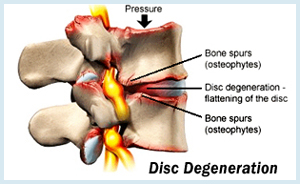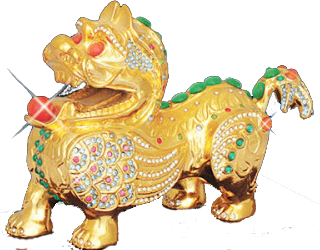Condition Treated / Pain Conditions
Degenerative disc disease
Degenerative disc disease
Degenerative disc disease is not really a disease but a term used to describe the normal changes in your spinal discs as you age. Spinal discs are soft, compressible discs that separate the interlocking bones (vertebrae) that make up the spine. The discs act as shock absorbers for the spine, allowing it to flex, bend, and twist. Degenerative disc disease can take place throughout the spine, but it most often occurs in the discs in the lower back (lumbar region) and the neck (cervical region).
The changes in the discs can result in back or neck pain and/or ;
- Osteoarthritis, the breakdown of the tissue (cartilage) that protects and cushions joints.
- Herniated disc, an abnormal bulge or breaking open of a spinal disc.
- Spinal stenosis, the narrowing of the spinal canal , the open space in the spine that holds the spinal cord.
These conditions may put pressure on the spinal cord and nerves, leading to pain and possibly affecting nerve function.
The causes of degenerative disc disease
As we age, our spinal discs break down, or degenerate, which may result in degenerative disc disease in some people. These age-related changes include:
- The loss of fluid in your discs. This reduces the ability of the discs to act as shock absorbers and makes them less flexible. Loss of fluid also makes the disc thinner and narrows the distance between the vertebrae.
- Tiny tears or cracks in the outer layer (annulus or capsule) of the disc. The jellylike material inside the disc (nucleus) may be forced out through the tears or cracks in the capsule, which causes the disc to bulge, break open (rupture), or break into fragments.
These changes are more likely to occur in people who smoke cigarettes and those who do heavy physical work (such as repeated heavy lifting). People who are obese are also more likely to have symptoms of degenerative disc disease.
A sudden (acute) injury leading to a herniated disc (such as a fall) may also begin the degeneration process.
As the space between the vertebrae gets smaller, there is less padding between them, and the spine becomes less stable. The body reacts to this by constructing bony growths called bone spurs (osteophytes). Bone spurs can put pressure on the spinal nerve roots or spinal cord, resulting in pain and affecting nerve function.
What are the symptoms?
Degenerative disc disease may result in back or neck pain, but this varies from person to person. Many people have no pain, while others with the same amount of disc damage have severe pain that limits their activities. Where the pain occurs depends on the location of the affected disc. An affected disc in the neck area may result in neck or arm pain, while an affected disc in the lower back may result in pain in the back, buttock, or leg. The pain often gets worse with movements such as bending over, reaching up, or twisting.
The pain may start after a major injury (such as from a car accident), a minor injury (such as a fall from a low height), or a normal motion (such as bending over to pick something up). It may also start gradually for no known reason and get worse over time.
In some cases, you may have numbness or tingling in your leg or arm.
How is degenerative disc disease diagnosed?
Degenerative disc disease is diagnosed with a medical history and physical exam. Your doctor will ask about your symptoms, injuries or illnesses, any previous treatment, and habits and activities that may be causing pain in the neck, arms, back, buttock, or leg. During the physical exam, he or she will:
- Check the affected area's range of motion and for pain caused by movement.
- Look for areas of tenderness and any nerve-related changes, such as numbness, tingling, or weakness in the affected area, or changes in reflexes.
- Check for other conditions, such as fractures, tumors, and infection.
If your examination reveals no signs of a serious condition, imaging tests, such as an X-ray, are unlikely to help the diagnosis. Imaging tests may be considered when your symptoms develop after an injury, nerve damage is suspected, or your medical history suggests conditions that could affect your spine, such as bone disease, tumors, or infection.
How is it treated with acupuncture?
Acupuncture uses very fine needles—and no medication—to treat your pain. Practitioners believe that you have an energy force called your Chi (it can also be spelled Qi, but both forms are pronounced “chee”). When this force is blocked, you can develop physical illness, such as back pain. Therefore, you need to free up your body’s Chi channels, which practitioners call your meridians. Acupuncture works to restore a healthy, energetic flow of Chi.
Acupuncture needles are almost as thin as strands of hair. Based on your symptoms and exact diagnosis, a practitioner will insert the needles; you’ll most likely have multiple needles inserted during one session. The practitioner will target precise points in your body’s meridians, and the needles will be left in for 20-40 minutes.
Acupuncture needles cause your body to release certain neurochemicals, such as endorphins or serotonin, and they help in the healing process.

Pain Care Acupuncture Clinic is your local acupuncture office in Torrance, CA . specializing in treating injuries and chronic pain. Dr. Ming Chen and Dr. Lu Yang, Both acupuncturists who also the oriental medical doctor ( O.M.D. ) can pinpoint the cause of the injury and suggest the best treatment methods for you. You need our doctor to listen to the whole story and examine you, so that you can get started treating on your injuries or chronic pain and get you on the track toward recovery.
Call now for a free health consultation !
Visit out Pain Care Acupuncture Clinic in;
21320 Howthorne Blvd., Suite 203 Torrance, CA 90503
quick link
Condition Treated
- Pain Conditions
- Respiratory System Conditions
- Digestive System Conditions
- Circulatory System Conditions
- Blood System Conditions
- Endocrine System Conditions
- Nervous System Conditions
- Urogenital System Conditions
- Gynecological Conditions
- Tumour Conditions
- Emotional/Behaviour Conditions
- Sensor Organ Conditions
- Skin Conditions
- Other Conditions
 La acupuncture
La acupuncture













